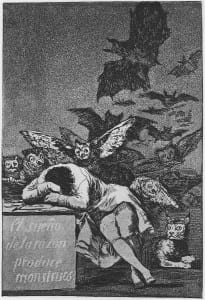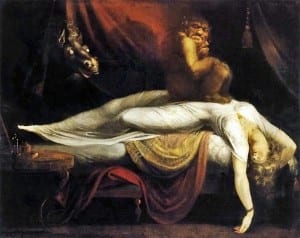The Gothic Tradition – Romanticism 12/02/13
A genre of writing called ‘Terrorist Writing’ was the eventual name for the Gothic. It was originally viewed with a lack of seriousness and from the work of women writers.
There was a sense of monstrosity in terms of setting. Very stereotypical, stylised gothic buildings containing remote passageways, cellars with a sense of mystery embodied. There were also outdoor settings such as forests with the feeling of the wildnerness and secrecy within.
Very much transgressing moral and social values, with excess of male power, violence and sexual deviancy. Supernatural features, e.g. giant suits of armor, moving portraits explained supernaturally but with suggestions of a naturalistic explanation in the end. The idea of the ‘unspeakable’ was prominent and the characters tend to be stereotyped. e.g. power vs helpless victims. There was also a fairytale sense in the characters, with extreme emotional registers, literature to excess.
1716 – 1820 – Housed the idea of the pure Gothic novel with all these conventions. After this the Gothic became mixed up with realism e.g. Jane Eyre, Great expectations, Dracula, Frankenstein …
There was also a fad for Gothic architecture with medieval aesthetics. e.g. Notre Dame and Lincoln Cathedral.
In the Mysteries of Udolpho there is the idea of entering the chamber, (similar to Angela Carter’s later work) and the idea of terror dragging your imagination because into the unknown
‘Emily passed on with faltering steps, and having paused a moment at the door, before she attempted to open it, she then hastily entered the chamber, and went towards the picture, which appeared to be enclosed in frame of uncommon size, that hung in a dark part of the room. She paused again, and then, with a timid hand, lifted the veil; but instantly let it fall – perceiving that what it concealed was no picture, and, before she could leave the chamber, she dropped senseless to the floor. (Vol 2 Ch 6)
Introducing stereotypical Gothic themes, haunting, groans, apparitions, mutilated bodies, decaying corpses, violent deaths, sexual threats. Freudian readings etc.
This became the explained supernatural with suggestions of fear and fear becoming pleasurable.
‘The Romantic Gothic’
It was revolutionary Gothic e.g. Frankenstein, Mary Shelleys parents were both renowned political radicals and both parents were right in the centre of radical political discourse. The monster in political terms presented himself as the victim (e.g. Frankenstein), the monster speaks back and protests and the narrative encourages sympathy. The social construction of monstrosity, symbolic of the french revolution in the terror and execution and violent aftermaths. The monster was arguably used in the Gothic as a warning to society, of society creating its own monster.
The Gothic became more and more an opposition to enlightenment values. It came to symbolise everything deemed ‘other’, a dark barbaric genre in comparison to the literature people were used to. The Gothic houses abuses of power, primitive social power and emotional access compared to enlightenment values of reason. The Gothic was desperate for punctuation, a form of writing that reflected the monstrosity of the writing at the time.
‘The idea of the absolute monarchy and the contemporary resonances of this. Presenting limits to a Kings power e.g. The Magna Carter and The Glorious Revolution. (Horace Walpole, John Wilks)
A certain emotional discourse presented the Gothic with relations to Romanticism, exploring interior worlds, introducing the idea of the ‘sublime’, an encounter with the unknowable, producing feelings akin to awe.
‘Sublimity, then, refers to the moment when the ability to apprehend, to know, and to express a thought of sensation is defeated. Yet through this very defeat, the mind gets a feeling for what which lies beyond our thought and language’ (Philip Shaw, The Sublime)
Suggestions of fear being part of the sublime, in alignment with the unspeakable. Obscurity seemed to be necessary to attain fear.
The attitude to the Gothic has varied quite a bit, are there serious ways to discuss the Gothic?
1) Symbolic Dramas of the unconscious, (Freud)
Fairy tale and dreams embodied ideas of the unconscious, symbolic narratives exploring what lies beneath the conscience. (See Goya painting) Origins of the dream were explored, dream like qualities emerging in literature, events drifting into each other producing powerful symbolic images but not necessarily being coherent (state of the dream or nightmare). In the mid 20th century, the surrealist movement – there was a fantasy of power unleashed paranoia,extreme mental states. Helplessness in nightmares, themes of claustrophobia and entrapment in the passage ways of a Gothic setting (ANGELA)
2) Political discourse
Gender binaries – indirect engagement with social reality. The male tyrant vs the female victim in patriarchal society. Exploration of what exactly makes the woman a victim, power being socially instituted by law, attitudes and culture. Exploration of feminism, women were presented as very unnatural. The representation of the monster in many works were symbolic of the narrative itself. e.g. The monster in Frankenstein was seen as symbolic of ‘the angry mob’ e.g. french revolution
3) Psychological Plight
Mechanics of Gothic machinery became metaphors of an internal landscape. Disturbed states of feeling and mind.
The internalising of Gothic forms represents the most significant shift in the genre, the gloom and darkness of sublime landscapes becoming external markers of the inner mental and emotional states’ (Botting,Gothic, 91-2)
See Coleridges ‘Pains of sleep’ – for images of the tortured mind.
The Romantic and the Gothic had a few things in common also.They were both beyond reason, imagination and feeling reacting against the rational world view. Emphasis on the subjective world and a reinvestment in the supernatural, hauntings, apparitions. Both engage with the sublime


